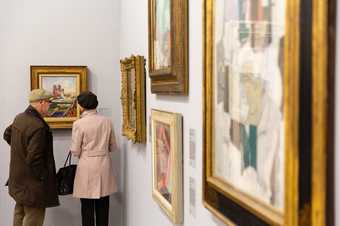This room suggests a range of styles and ideas that concerned modern European artists between the wars
This display brings together national and international figures that were seeking a new language for art following the atrocities of the First World War, while sensing the anxieties of the next.
In the 1920s a circle of modern artists in London wanted to portray a more direct response to the world. British painters Ben Nicholson and Christopher Wood looked to the untutored work of Cornish fisherman Alfred Wallis. For sculptors Henry Moore and Barbara Hepworth, it came from studying ethnographic carvings in the British Museum. Along with Bernard Leach, the potter who moved to St Ives from Japan in 1920, each artist emphasised the handmade, material qualities of their work.
The 1930s brought the rise of fascism and social unrest in Europe. Groups and publications in London and Paris such as ´ˇ˛ú˛őłŮ°ů˛ął¦łŮľ±´Ç˛Ô-°ä°ůĂ©˛ąłŮľ±´Ç˛Ô, Axis and
Circle sought to unite like-minded artists, architects and writers. From Dutch painter Piet Mondrian and Russian sculptor Naum Gabo to British artists
Marlow Moss and Barbara Hepworth, non-representational abstract art had become linked to hopes for an international, spiritually enriched, politically
harmonious art and society.
Others expressed the fears and uncertainties of the decade through responses derived from the unconscious. Dreamlike images of everyday
objects and ominous landscapes came to the fore in the work of British artists Graham Sutherland, Paul Nash and Eileen Agar.
Tate St Ives
Entry to both the display and the gallery is free for Tate Members, Locals' Pass holders and under 18s.

